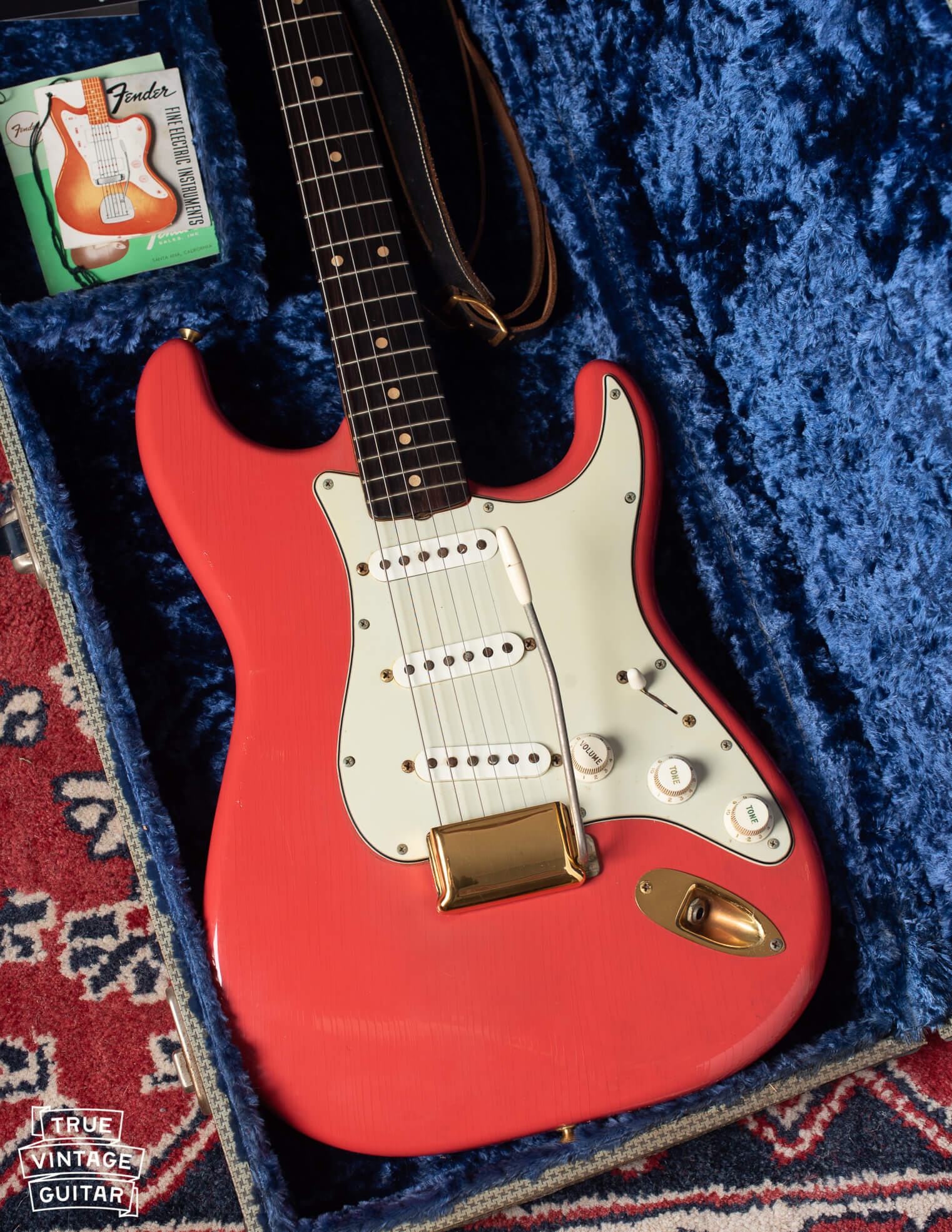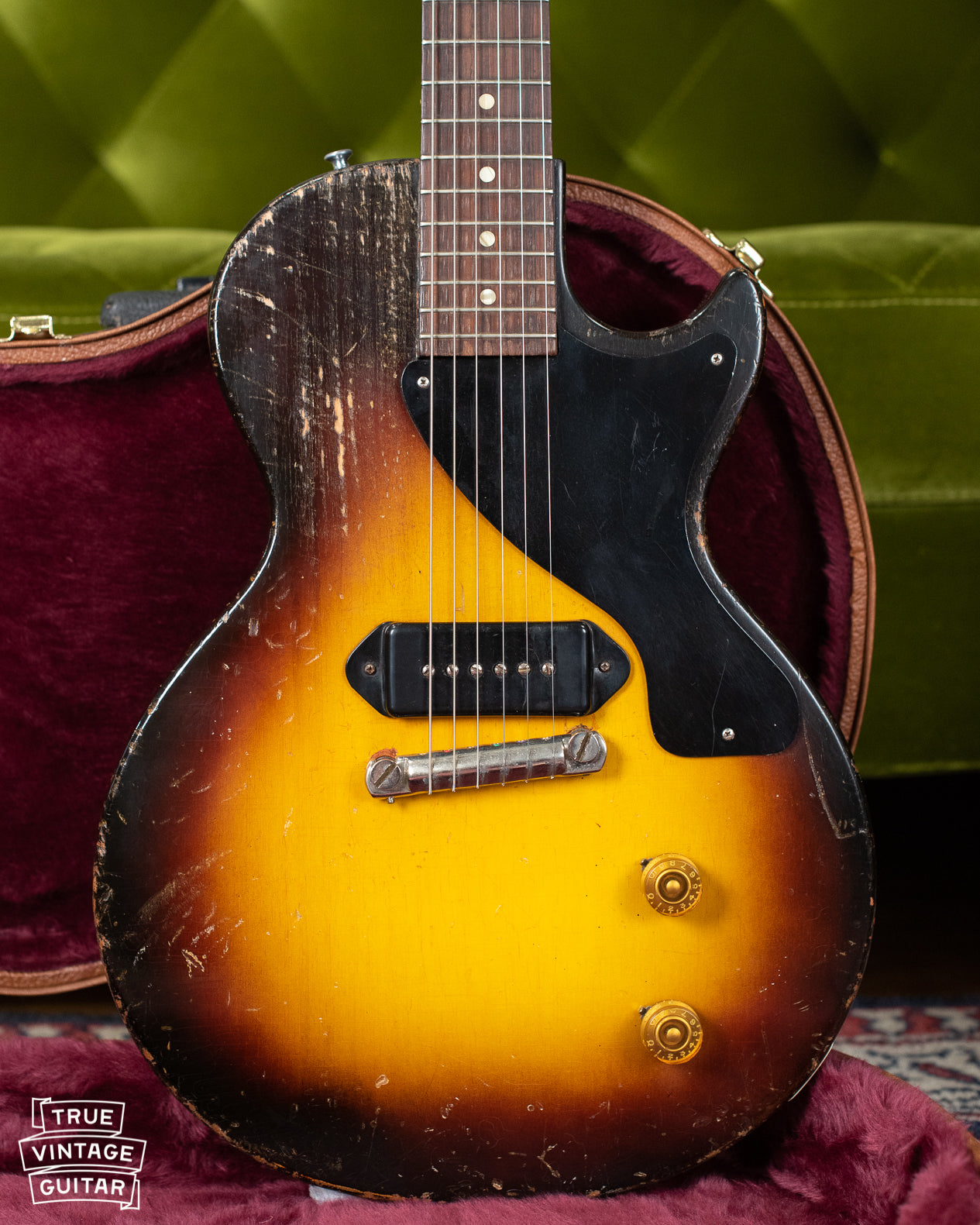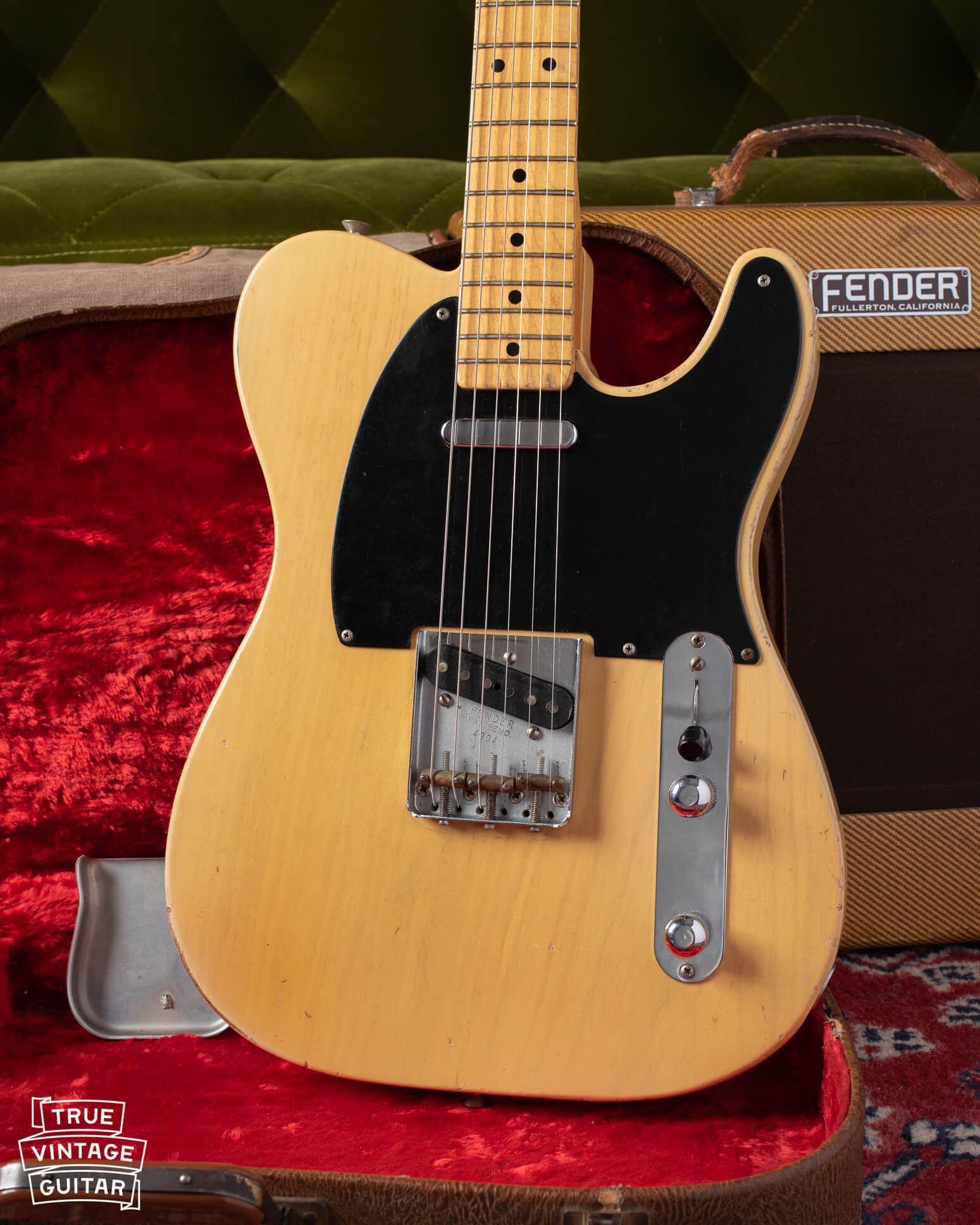How much is a 1950s & 1960s Stratocaster Worth?
Use this guide to determine the value of your Fender Stratocaster made during the 1950s and 1960s. Consider a few key factors to get a better understanding of why some vintage Stratocasters are priced higher than others: year of production, finish originality and color, overall condition, and the originality of its parts. You can use the information here to make an informed decision about its potential value before looking to sell to a guitar collector.
The value of an original 1950s or 1960s Stratocaster can be anywhere between $10,000 up to $200,000+ for rare and clean examples. You can call us for help 659-208-7374 or use this contact form:
How to find the value of your Stratocaster: Get a professional appraisal. The price of a vintage Stratocaster floats over time, so it's best to have a current professional appraisal of your guitar.
The value guide below will help explain how a professional appraiser evaluates a vintage Stratocaster. I've added grades to different years and features so that you can compare the value of your Strat to other Strats that are currently for sale. You can begin to see for yourself what a guitar collector might see as they're looking for their dream guitar.
How to determine the value of your Stratocaster in four steps:
1. Identify the year of manufacture: Use both the serial number and the features to confirm its age.
2. Determine originality of finish, identify the color, and hardware: A refinish can diminish the value by 50%, but a rare custom color can be worth 50% more than a standard Sunburst!
3. Assess its overall condition: Rough condition won't necessarily turn off a buyer, but they will likely want a pricing discount because of it.
4. Determine the originality of its parts: Some replaced parts will negatively affect the value more than others.
Get an appraisal for a vintage Stratocaster:
We love talking about vintage Stratocaster values: Appraisal (for Fender guitars from the 1950s and 1960s only). We serve buyers and sellers of high end, vintage collectible USA made guitars exclusively. There's no charge for us to have a look at your Strat and discuss our opinion of value with you. Or if you need an appraisal for insurance purposes, then we'd be happy to provide that for you for a fee for the document.

1. Stratocaster value by year of manufacture:
The serial number is one quick way to find the year of a Stratocaster, but it's only the first step identifying the year of manufacture. You can use our Fender Serial Lookup to quickly check the serial number of your Stratocaster. Be advised that Stratocaster serial numbers are located on easily replaceable parts from 1954 until 1976, so it's not the only way to identify the year it was made.
The value of a Stratocaster depends heavily on the year it was manufactured. The relationship between the supply and demand of Stratocasters from certain years is the force that drives the price. Consider how the first run of Stratocaster from the Spring of 1954 consisted of less than 200 guitars, but by 1966, Fender produced more than 5,000 examples per year. The supply of early Stratocasters is vastly lower than 1966, but the demand for them is also much stronger, so the price is many times higher.
You can also check out this page for help to find out what year your Stratocaster was made: How to date a Stratocaster. There are many different features on Strats which a collector can check to determine the year. These features can also be helpful to date different parts of a Stratocaster which may have been modified over time.
It's not possible to assess the value of a Stratocaster by serial number, but rather that serial number can lead you the right year. Once you've correctly identified the year, the range of value is more defined.
Here's a list of value grades for different years of the Stratocaster. You can contact me for help with verification, value, or to sell: 659-208-7374 or John@truevintageguitar.com:
| Year | Sunburst Retail Price Range |
|---|---|
| Spring 1954 | $60,000 – $125,000 |
| Summer 1954 | $50,000 – $100,000 |
| Late 1954 | $50,000 – $75,000 |
| 1955–1956 | $35,000 – $55,000 |
| Mid 1956–1957 | $25,000 – $50,000 |
| 1958–Mid 1959 | $20,000 – $45,000 |
| Mid 1959–1960 | $30,000 – $50,000 |
| 1961–Mid 1962 | $25,000 – $45,000 |
| Mid 1962, 1963, 1964 | $20,000 – $35,000 |
| 1965 | $16,000 – $28,000 |
| 1966–1968 | $12,000 – $22,000 |
| 1969–1971 | $7,000 – $14,000 |

2. Value by originality: Finish and hardware:
The value of your Stratocaster is significantly lower if any part (body or neck) has been refinished (nearly 50% lower than that of an original finish!). If the finish is original, then the value of a custom color Stratocaster will be much higher than that of the standard Sunburst color. Fender's own catalogs offered both custom finishes (5% extra) and also a hardware finish upgrade to gold plating. Fender guitars with gold parts are exceptionally rare, so a custom finish with gold parts will be worth much more than a comparable Sunburst guitar from the same year.
Finish authentication: Authenticating a Fender finish requires cross referencing the subtle features not visible from the outside of the guitar. The manufacturer continually updated their finishing process throughout the years as techniques improved. That's why authenticating a Stratocaster finish from 1957 is completely different from that of a Strat made in 1967. It's important to cross reference the features of the finish on your Strat to others made during that time period. The following chart shows some of the timeline of features.
Get professional help to authenticate your Stratocaster: Appraisal.
Fender Finish Authentication Notes (1954-1969)
| Year | Sunburst & Blond | Custom Colors |
|---|---|---|
| 1954-1956 | 4 nail holes, no red band | Case by case |
| 1957 | 4 nail holes, no red band | desert sand undercoat |
| 1958-1963 | 3 nail holes, red band (Sunburst) | desert sand undercoat |
| 1963 | Paint stick, 3 nail holes | Transition to white undercoat |
| 1964 | Paint stick, some with no nail holes | White undercoat |
| 1965-1968 | Paint stick, no nail holes | White undercoat |
| 1968-1969 | Transition from Nitrocellulose to Polyurethane finishes | |
You may wish to have an expert opinion on your Strat: Appraisal. You may be asked to allow an appraiser the disassemble part of your Stratocaster to search for important tells which aren't visible from the outside.

Easiest way to assess the finish on a Stratocaster: The first place that I look when determining an original finish is underneath the output jack plate. The output jack plate is affixed to the guitar with only two Phillips head screws, so it's easy to remove and replace with no evidence or risk to the Strat. Once under the plate, I look for the following: clean output jack solder, possible clear nail hole, evidence of another finish under the current finish, undercoat, cavity edges, etc.
If the finish on your Stratocaster is original, then the color becomes a very important factor in determining its value. Fender guitars were offered in a standard color, but by 1957, could be ordered in a custom color for 5% more than the standard price. Most guitar players were satisfied with Sunburst and didn't feel the need to pay extra for something different. The majority of Strats were made in Sunburst so that's an easy color for a collector to find.
Custom Colors: From 1957 until 1961, Fender would finish a Stratocaster in any Duco (Dupont) color you wished for a 5% upcharge. A standardized color chart was offered by Fender with its own names for the colors by the Summer of 1961. The chart changed in 1963, then changed again in 1965. Some colors such as Candy Apple Red Metallic and Olympic White were very popular, so many more were ordered than uncommon colors such as Foam Green, Surf Green, and the impossibly rare: Shell Pink. Stratocaster in rare colors are often far more valuable than common colors.
If you have a Stratocaster in any of these colors then you can contact me here: Sell a Fender.
| Color Category | Colors | Value Increase Over Sunburst |
|---|---|---|
| Standard Color | Sunburst | Baseline |
| Most Common Custom Colors | Candy Apple Red, Olympic White, Blond, Lake Placid Blue | Moderate |
| Uncommon Colors | Fiesta Red, Black, Dakota Red, Inca Silver, Shoreline Gold, Burgundy Mist, Daphne Blue, Sonic Blue | Significant |
| Rare Colors | Sherwood Green, Foam Green, Surf Green | Very Significant |
| Unobtainium | Shell Pink | Extremely Significant |
Gold hardware: A quick glance at the Fender catalog from 1957 shows that the most expensive Strat was the Blonde finish with "14 Carat Gold-Plated Hardware". Gold hardware was 20% more expensive than the standard chrome finish hardware, so few were ordered. Stratocasters with gold parts are very uncommon and can bring a price much higher as a result.
I'm especially interested in vintage Stratocasters with gold hardware and/or custom color finishes: Sell a Fender.
3. Stratocaster Value by condition:
The way that the condition of a vintage Stratocaster affects its value is more subjective than the rest of the evaluation. A mint or near mint example will almost always be more valuable than a worn example. The Stratocaster was such a useful tool that nearly all of them have been played heavily throughout the decades. It's rare to come across one that has very low miles and is very well preserved. It's especially rare to come across a custom color in mint or near mint condition. The combination of rare custom color and near mint condition can increase its value significantly.
Finish wear: Heavily played Strats will have large areas of finish missing from the forearm area the body and the back of the neck. While not a turn off for most buyers, they will certainly want a discounted price because of it.
Finish discoloration: Custom colors made after 1963 typically have a clear coat over the color coat which can cause discoloration. The amber hue of the oxidized clear coat is what makes a Lake Placid Blue finish look more like Sherwood Green. An oxidized (or "faded") custom color finish will almost always be less valuable than a comparable unfaded finish.

4. Determine the originality of its parts:
As with all valuable collectibles, original parts are almost always best for vintage Stratocasters. There are some parts which are more commonly replaced than others such as frets which affect the value less significantly than uncommonly replaced parts like the neck or the pickups.
Neck or Body: Since the Stratocaster is easily disassembled with the four screws on the back of the body, it's possible that the neck or body was replaced at some point. Sometimes Fender itself would replace a neck or a body during a factory refinish (or factory update). A thorough understanding of the Stratocaster timeline is required to authenticate both the body or the neck, so a professional appraisal would be helpful for this part.
Pickups: It's very common for 1950s/1960s Stratocaster pickups to fail even if the guitar is undisturbed and unplayed. Many players in the past thought it was necessary to replace a pickup if it failed, so replaced pickups are unfortunately common. Lucky for us today, skilled pickup rewinding service is much easier to find. Replaced pickups in a old Strat will affect its value significantly since it's never necessary to replace them.
Pickup style timeline:
| Year | Bobbin Color | Features |
|---|---|---|
| 1954-1956 | Black | "nibs" next to eyelets, tall G pole, north to strings, Formvar |
| 1957-1960 | Black | No nibs, short G pole, north to strings, Formvar |
| 1960-1964 | Black | south to strings, Formvar |
| 1964 | Grey | Yellow date stamp, plain enamel, white/black leads |
| 1964-1966 | Grey | Pencil or ink handwritten dates, plain enamel, |
| 1967-1968 | Black | Plain enamel, yellow/green or blue cloth leads |
| 1969 | Grey | Plastic leads |
Tuners: Tuning stability can plague any old Stratocaster, so many previous owners thought that replacing the tuning machines would solve the problem. I've found that the tuning machines are almost never the problem, but that a proper set up, cleanly cut nut, and some lubrication will resolve the majority of issues. It's almost never necessary to replace the tuners, but if you must, then always replace with the same style and screw pattern so that the wood remains unmodified. Stratocasters with oversized tuning machines installed such as those from Grover and Schaller will certainly decrease a collector's interest and therefore its value.
| Year | Brand | Style |
|---|---|---|
| 1954-1956 | Kluson | No line |
| 1956-1964 | Kluson | Single line |
| 1964-1966 | Kluson | Double line |
| 1966-1970 | Schaller | F logo |
Plastics (pickguard, knobs, pickup covers, etc): The plastic bits on the front of a Stratocaster may not affect the tone of the guitar, but they're some of the first things you see when you look at it. Replaced pickguards will stick out significantly to the eye of the buyer, so the value can be significantly affect. The knobs and pickup covers too can be pretty obvious, but they're less likely to turn away a buyer than a replaced pickguard.
Frets: Frets are the thin metal strips which bisect the fretboard and allow the player to accurately make a note. Frets wear over time, so Strats which have been played a lot will have wear on the frets significant enough that the guitar is difficult to play. Most collectors will prefer a refret in this case, but there are many differing opinions on how the refret should be performed. My opinion is that a properly executed refret in the factory style will at least as valuable as the same guitar with original frets that are too worn to comfortably play.
Improper refrets: In the past, it was common for luthiers to plane the fretboard during a refret to achieve a perfectly straight fretboard before installing new frets. My opinion is that anything more than the gentlest, undetectable fretboard plane will decrease the value of a vintage Stratocaster. If the neck is not straight, then removing wood will not improve the guitar. Planing the wood off the board on a twisted or warped neck will irrevocably change the guitar. We have found that a skilled luthier can heat press a neck straight in order to avoid planing the board. When executed properly, there will be no evidence of the heat press and that the neck will continue to be straight as long as it's not subjected to the same forces which caused it to warp in the first place.
Assessing the value of your vintage Stratocaster:
The previous steps detail the process that I use the assess the value of a Fender Stratocaster from 1950s and 1960s. We can begin to categorize them starting with the year, then the color/finish originality, then the "mileage" or wear, the an evaluation of original parts in that order.
If you'd like a professional appraisal of your Stratocaster, feel free to reach out to our experts: Contact Me.
We work with high end, vintage collectible Stratocasters world wide every day. I'm not concerned with exactly where the guitar is, as much as what the guitar is. I've purchased Strats from coast to coast in the US, Canada, England, Scotland, South Africa, Mexico, and more. If you have a vintage collectible Stratocaster then I'd be happy to have a look at it.
FAQs about Stratocaster Values
Q: What is the most valuable year for the Stratocaster?
A: 1954. 1954 is both the first year for the model and likely to be the lowest production year as well (although exact production figures are still unknown). More information here: 1954 Stratocaster.
Q: At what age is a Stratocaster considered "vintage"?
A: While opinions vary, this collector uses the term "vintage collectible" to define Strats made during the 1950s and 1960s only. Production output in the 1970s ballooned so large that the supply of those guitars often outpaces the demand even today.
Q: Can you check the value of a Stratocaster by serial number?
A: This approach fails to consider how the color, bridge style, condition, and originality affect the value of a Stratocaster. Fender Serial Numbers can be helpful in dating the guitar, but values for Stratocasters depend on so much more than simply the year it was made. Guitar collectors also factor in the color, condition, originality, and bridge style.
You can contact me for a professional opinion of value for Stratocasters made between 1954 and 1969:
Q: How much does a refinish affect the value of my vintage Stratocaster?
A: A refinished vintage Stratocaster is usually assumed to be worth about half of a comparable example with original finish. The quality of the refinish and color can also effect how much a player or collector is willing to pay for it.
Q: Should I restore my vintage Stratocaster before selling it?
A: No. Fender guitar collectors have their own way of fixing problems and bringing the guitar back to the state that the manufacturer intended it. You will not likely achieve a higher price by replacing more parts.
Q: Should I sell my vintage Stratocaster on Reverb or eBay?
A: This can be a good option for guitars valued less than $10,000. Insuring guitars for shipment becomes very difficult for private sellers for sales over $10,000. Reverb's fine print states that sales over $10,000 are not eligible for any amount of insurance. No carrier offers insurance for musical instruments older than 1980 for more than $5,000 (check the fine print!).
I offer fair prices paid for 50s and 60s Stratocasters with no shipping liability: Sell a Fender.
From Reverb's Safe Shipping information page:
"Neither Safe Shipping nor Reverb Shipping Labels are available for items with a sale price of $10,000 or more."
"For international shipments, Safe Shipping is unavailable for orders exceeding $2,500."
From FedEx's Terms of Service:
"Shipments (packages or freight) containing all or part of the following items are limited to a maximum declared value of US$1,000: ...
...12. Guitars and other musical instruments that are more than 20 years old, and customized or personalized musical instruments."
From UPS's terms of service:
"When a Shipper declares a value in excess of $100, it does not receive any form of insurance. Shippers desiring cargo insurance, all risk insurance, or another form of insurance should purchase such insurance from a third party."
About John Shults: 16 Year Veteran Stratocaster Appraiser and Collector

I began collecting old Fender guitars and amplifiers as a Sophomore in college in 2009. I began with a Fender Duo Sonic made in 1964, then a 1965 Jazzmaster, then a vintage Jaguar, but my interests eventually veered towards the finest Fender model of them all: The Stratocaster. Since then, I've travelled all over the US and even internationally to find and purchase the vintage Stratocasters I've always dreamed of.
If you've inherited a Stratocaster from the 1950s or 1960s and are looking for help with identification, value, or a possible buyer then you can contact me here: Sell a Fender.




Comments
I’ve got a completely random question I was hoping somebody could help me out with. I myself am artist and recently I’ve started using guitars as my canvas and transforming them into some pretty good looking pieces of art. Now my question is how do I go about setting a price on these pieces of art. When I’m done they’re completely functional instruments just with added character. Sure you might say it’s then my artwork so I set the price but I’d like a collected opinion from the artists on the receiving end of the situation and what you feel is a safe starting point pricewise without over doing it. Thanks.
Something is only worth what someone is willing to pay for it. Vintage nuts pay thousands of dollars
For old guitars . But from my perspective they are making far better guitars today then they ever did back on the 50’s. There isn’t that much as far as electronics go involved in an electric guitar anyway
As nd wood is wood. The necks are made to much better tolerances then in the old days.
Hello-
I’m looking for some help, and your site here might be just the ticket
I have a chance to buy a Fender Stratocaster from my cousin and aunt. It was my uncle’s- (deceased). I doubt he played it more than just a few times, and it’s been sitting in a closet probably for decades. By the serial number- (MN8284022)- I believe it was made in Mexico in 1998. I’ve seen pics of it, and it seems to look like it’s in good shape, but I haven’t put my hands on it yet. It has a Fender “25-something” amp with it- (I’ve seen lots of this one on Ebay for ~$50-100. It has some rust or something on the (black) metal grille on the front of the amp. I’m sure it has a nice case along with.
I have several acoustic guitars- (including a Fender!)- but never owned an electric guitar. Only played around on one 4-5 times in my life.
I kind-of want it— but “kind-of don’t want it” also.
Do you have ANY idea what it may be worth? I certainly don’t want to be disrespectful with a “too low” offer- (they are family)- but don’t want to overpay either.
Help!!!! Thank you for ANY info you can throw my way!
Mark